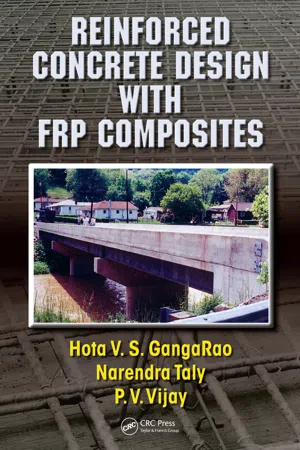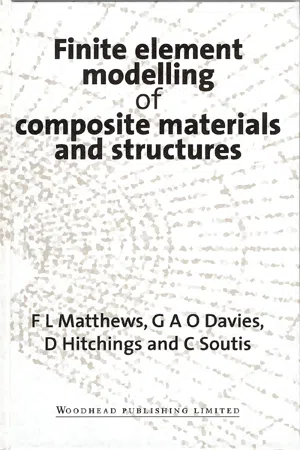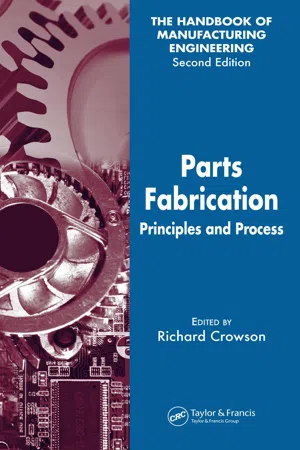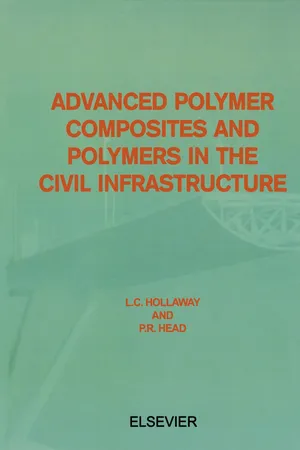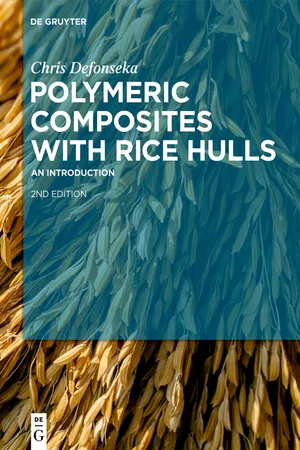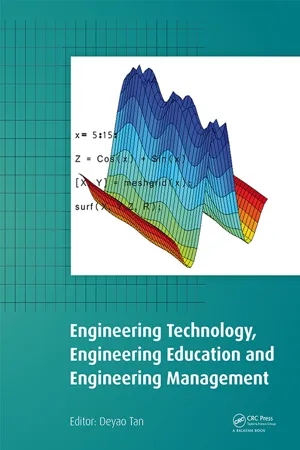Technology & Engineering
Composite Material
Composite materials are engineered materials made from two or more constituent materials with significantly different physical or chemical properties. These materials are combined to produce a final product with enhanced properties such as strength, stiffness, and durability. Common examples of composite materials include fiberglass, carbon fiber, and reinforced concrete.
Written by Perlego with AI-assistance
Related key terms
1 of 5
10 Key excerpts on "Composite Material"
- Hota V.S. GangaRao, Narendra Taly, P. V. Vijay(Authors)
- 2006(Publication Date)
- CRC Press(Publisher)
19 2 Properties of Constituent Materials: Concrete, Steel, Polymers, and Fibers 2.1 INTRODUCTION Development of Composite Materials represents a milestone in the history of our civilization. Along with conventional building materials such as steel, concrete, alu-minum, and wood, Composite Materials offer an excellent alternative for a multitude of uses. Use of Composite Materials was pioneered by the aerospace industry beginning in the 1940s, primarily because of the material’s high-performance and lightweight qualities. Today their potential is being harnessed for many uses. Advanced Composite Materials — so called because of their many desirable properties, such as high-performance, high strength-to-weight and high stiffness-to-weight ratios, high energy absorption, and outstanding corrosion and fatigue damage resistance — are now increasingly used for civil engineering infrastructure such as buildings and bridges. Composite Materials are manufactured from two or more distinctly dissimilar materials — physically or chemically — that are suitably arranged to create a new material whose characteristics are completely different from those of its constituents. Basically, composites consist of two main elements: the structural constituent, which functions as the load carrying element, and the body constituent called matrix , which encloses the composite. The structural constituent can be in the form of fibers, particles, laminae (or layers), flakes, and fillers. The matrix performs important dual functions: It acts as a binder to hold the fibrous phase in place (i.e., holds the fibers in a structural unit) protecting fibers from environmental attack, and under an applied load, it deforms and distributes the load to the high modulus fibers. Composites discussed in this book are those fabricated from fibers such as glass, carbon, aramid, and boron.- eBook - PDF
Composites Manufacturing
Materials, Product, and Process Engineering
- Sanjay Mazumdar(Author)
- 2001(Publication Date)
- CRC Press(Publisher)
Ceramics cannot be processed by common metal- lurgical techniques and require high-temperature equipment for fabrication. Due to their high hardness, ceramics are difficult to machine and therefore require net-shape forming to final shape. Ceramics require expensive cutting tools, such as carbide and diamond tools. 1.1.4 Composites Composite Materials have been utilized to solve technological problems for a long time but only in the 1960s did these materials start capturing the attention of industries with the introduction of polymeric-based composites. Since then, Composite Materials have become common engineering materials and are designed and manufactured for various applications including automotive 4 Composites Manufacturing: Materials, Product, and Process Engineering components, sporting goods, aerospace parts, consumer goods, and in the marine and oil industries. The growth in composite usage also came about because of increased awareness regarding product performance and increased competition in the global market for lightweight components. Among all materials, Composite Materials have the potential to replace widely used steel and aluminum, and many times with better performance. Replacing steel components with composite components can save 60 to 80% in component weight, and 20 to 50% weight by replacing aluminum parts. Today, it appears that composites are the materials of choice for many engi- neering applications. 1.2 What Are Composites? A Composite Material is made by combining two or more materials to give a unique combination of properties. The above definition is more general and can include metals alloys, plastic co-polymers, minerals, and wood. Fiber-reinforced Composite Materials differ from the above materials in that the constituent materials are different at the molecular level and are mechan- ically separable. In bulk form, the constituent materials work together but remain in their original forms. - F L Matthews, G A O Davies, D Hitchings, C Soutis(Authors)
- 2000(Publication Date)
- Woodhead Publishing(Publisher)
Also some features of composite construction, such as filament winding, cannot easily be represented (if at all) by some FE packages. Following a review of com-posites and the FE method, the application of the method to composites is discussed in detail. The particular issues are then illustrated via a number of examples taken from particular situations. Overview 5 2 Fundamentals of composites 2.1 Basic characteristics 2.1.1 Definitions and classification A composite is a mixture of two or more distinct constituents or phases. In addition three other criteria are normally satisfied before we call a ma-terial a composite. Firstly, both constituents have to be present in reason-able proportions. Secondly, the constituent phases should have distinctly different properties, such that the composite’s properties are noticeably different from the properties of the constituents. Lastly, a synthetic composite is usually produced by deliberately mixing and combining the constituents by various means. We know that composites have two (or more) chemically distinct phases on a microscopic scale, separated by a distinct interface, and it is important to be able to specify these constituents. The constituent that is continuous and is often, but not always, present in the greater quantity in the compo-site is termed the matrix. The normal view is that it is the properties of the matrix that are improved upon when incorporating another constituent to produce a composite. A composite may have a ceramic, metallic or poly-meric matrix. The mechanical properties of these three classes of material differ considerably. As a generalisation, polymers have low strengths and Young’s moduli, ceramics are strong, stiff and brittle, and metals have inter-mediate strengths and moduli, together with good ductilities, i.e. they are not brittle. Because of their economic importance, the emphasis in this text will be on polymer matrix composites (PMCs).- eBook - PDF
Parts Fabrication
Principles and Process
- Richard Crowson(Author)
- 2006(Publication Date)
- CRC Press(Publisher)
229 Composite Manufacturing John F. Maguire with Don Weed and Thomas J. Rose 6.0 INTRODUCTION AND BACKGROUND It is difficult to find a truly satisfactory definition of Composite Material. The American Heritage Dictionary (Houghton Mifflin, Boston, 1981) comes close, with “a complex material, such as wood or fiber glass, in which two or more complementary substances, especially metals, ceramics, glasses, and polymers, combine to produce some structural or functional properties not present in any individual component.” The problem with even a good definition, of course, is that it is all-encompassing, so that every material in the universe could in some sense be defined as a composite. This loss of exclusivity diminishes the usefulness of the definition. For our purposes, we shall restrict attention to that subset of materials known as fiber-reinforced advanced polymeric composites. In these materials, a reinforcing fiber is embedded in an organic polymeric resin. The fiber acts as a structural reinforcement and the resin binds the fibers together. This transfers loads and provides structural and dimensional integrity. Advanced Composite Materials, developed in the latter half of the twentieth cen-tury, may well provide a key to enabling technology for the twenty-first century. These materials are strong, light, and corrosion resistant, offering considerable tech-nical advantages in aerospace, automotive, offshore petrochemical, infrastructure, and other general engineering applications. Composite components may be made by laminating or laying up layers of Composite Material, each ply consisting of one or more patterns, which may be as large as 4 1/2 ft wide by 9 ft long. These patterns are cut from a continuous roll of cloth, or from sheets, with standard widths measuring up to 4 1/2 ft. Composite Material wider than 12 in. is referred to as broadgoods. If a material is narrower, it is usually a unidirectional tape. In such a tape the fibers run 6 - eBook - PDF
Engineering Fundamentals
An Introduction to Engineering, SI Edition
- Saeed Moaveni(Author)
- 2019(Publication Date)
- Cengage Learning EMEA(Publisher)
Cengage Learning reserves the right to remove additional content at any time if subsequent rights restrictions require it. 17.5 Wood, Plastics, Silicon, Glass, and Composites 713 Composites Because of their light weight and good strength, Composite Materials are increas- ingly the materials of choice for a number of products and aerospace applications. Today, you will find Composite Materials in military planes, helicopters, satellites, commercial planes, fast-food restaurant tables and chairs, and many sporting goods. They also commonly are used to repair bodies of automobiles. In comparison to conventional materials (such as met- als), Composite Materials can be lighter and stronger. For this reason, Composite Materials are used extensively in aerospace applications. Composites are created by combining two or more solid mate- rials to make a new material that has properties that are superior to those of the individual components. Composite Materials con- sist of two main ingredients: matrix material and fibers. Fibers are embedded in matrix materials, such as aluminum or other metals, plastics, or ceramics. Glass, graphite, and silicon carbide fibers are examples of fibers used in the construction of Composite Materials. The strength of the fibers is increased when embedded in the matrix material, and the com- posite material created in this manner is lighter and stronger. Moreover, once a crack starts in a single material due to either excessive loading or imperfections in the material, the crack will propagate to the point of failure. In a Composite Material, on the other hand, if one or a few fibers fail, it does not necessarily lead to failure of other fibers or the material as a whole. Furthermore, the fibers in a Composite Material can be oriented either in a certain direction or many directions to offer more strength in the direction of expected loads. Therefore, Composite Materials are designed for specific load applications. - L.C. Hollaway(Author)
- 2001(Publication Date)
- Elsevier Science(Publisher)
A number of processes for producing advanced Composite Materials for the civil engineering industry have been discussed above. There are, therefore, a number of options which can feasibly be used to obtain the same end product, but it was stated in Section 3.1 that the properties of a Composite Material can differ based upon manufacturing procedures, location and environmental factors. It is important, therefore, that the civil engineering designers be able to consider the uncertainty in these materials based upon aspects related to data generation, material characteristics (as related to long- and short-term durability) and processing routes. The designers have 46 Advanced polymer composites and polymers in the civil infrastructure over the years developed a range of design philosophies and methodologies to deal with uncertainty in loads and material properties. For instance in the ultimate strength design approach, adjusted ultimate nominal strengths of a member are compared with the structural effects of factored loads imposed upon the structural member. The effects of variations in material strengths, component geometries and any approximations inherent in the strength formulations are taken into account through strength reduction factors y, whereas the uncertainty in load is accounted for through factors ^/ (a load factor pertinent to the specific degree of uncertainty of load L,) where: i and 5n = nominal strength. In the ultimate limit state design approach (see Chapter 4), strength reduction factors are replaced by material coefficient factors, to account for variation in the strengths of individual constituents, rather than through a single value of y. The combined coefficient is then compared with the appropriate combination of factored loads for pre-specified ultimate limit state.- J. T. Black, Ronald A. Kohser(Authors)
- 2019(Publication Date)
- Wiley(Publisher)
There is often a degree of variability between nominally identical products, and inspec- tion and quality control methods are not as well developed as for other materials. While these limitations may be acceptable for certain applications, they often restrict the use of compos- ites for high-volume, mass-produced items. Faster production speeds, increased use of automation, reduced variability, and integrated quality control continue to be important issues in the expanded use of Composite Materials. In Chapter 8, Composite Materials were classified by their basic geometry as particulate, laminar, and fiber-reinforced. Because the fabrication processes are often unique to a specific type of composite, they will also be grouped in the same manner. Fabrication of Particulate Composites Particulate composites usually consist of discrete particles dis- persed in a ductile, fracture-resistant polymer or metal matrix. They offer isotropic properties and ease of fabrication relative to their fiber-reinforced counterparts. Their fabrication rarely requires processes unique to Composite Materials. Instead, the particles are simply dispersed in the matrix by introduction into a liquid melt or slurry, or by blending the various components as solids using powder metallurgy methods. Subsequent process- ing generally follows the conventional methods of casting or forming or utilizes the various techniques of powder metallurgy. These processes have been presented elsewhere in the text and will not be repeated here. Recent developments include the successful blending of reinforcement particles into the highly viscous slurries of rheo- cast material, the semisolid mixtures that are viscous when agitated but retain their shape when static. In the sinter-forge process, metal and ceramic powders (such as SiC and alu- minum) are blended, compacted at room temperature, sin- tered, and then hot forged to produce near-net-shape parts at near-full density.- eBook - ePub
Polymeric Composites with Rice Hulls
An Introduction
- Chris Defonseka(Author)
- 2019(Publication Date)
- De Gruyter(Publisher)
3 Composite technology3.1 Principles of composites
The general principle of a composite is the combination of ≥2 different components with a common base, which acts as the matrix. The new material will have the base properties of both components but better properties such as light weight, higher strength, aesthetic finishes, and wider end-applications depending on the design of the composite. In general, composites may cost more but polymeric composites with rice hulls (PCRH) will yield composites that are less expensive than standard ones (especially as a biomass waste); in this case, rice hulls are used as the constituent component. Composites with rice hulls will be considered in two segments: PCRH as pellets and PCRH as extruded profiles.Composites are usually made up of fibres and a matrix. Most commonly used fibres have been glass-fibres, Kevlar, carbon-fibres, and steel whereas, more recently, other reinforcement materials (e.g., biomasses) are being used. The fibre is embedded in the matrix to make the matrix stronger. Fibre-reinforced composites (FRC) have two special properties in that they are lighter and stronger, with some special composites being even stronger than steel but weighing much less. One of the main advantages of these types of composites is their ability to make automobiles and other vehicles lighter and thus fuel-efficient as well as lessening environmental concerns.Matrices provide a common base for holding together whichever reinforcements are used. Although some fibres are strong, they can be brittle. A matrix can absorb energy by deforming under stress (i.e., a matrix adds strength and toughness to a composite). Fibres may have good tensile strength (i.e., they are strong if pulled) but they usually have weak compression strength, and this is countered by the matrix. When making composites, the designers use different matrices for different end applications. If a cost-effective composite is desired, some cheap matrices can be used that will yield decent properties. The unsaturated polyester/styrene system is a good example. Cheap matrices are fine for everyday applications but have drawbacks. They shrink if cured, absorb water easily, have low impact strength, and are not very resistant to chemicals. However, with the advent of new technologies, as discussed in this book, whereby common polymers such as polyethylene (PE); polypropylene (PP); vinyls; and high-density polyethylene (HDPE) coupled with rice hulls (which contain high contents of silica) have opened up a vast array of possibilities. - eBook - PDF
- T. W. Clyne, D. Hull(Authors)
- 2019(Publication Date)
- Cambridge University Press(Publisher)
15 Fabrication of Composites An important aspect of Composite Materials concerns the technology by which they are produced. Depending on the nature of matrix and fibre, and the required architecture of fibre distribution, production at reasonable cost and with suitable microstructural quality can present a challenge. In most cases, manufacture of the final component and production of the Composite Material are carried out at the same time. This gives scope for optimal fibre placement and distribution of orientations, but also requires that the mechanical requirements of the application be well understood and that the processing route be tailored accordingly. Fabrication procedures for most commercially important (fibre-reinforced polymer) composites are technically mature, but there are some types of composite for which processing routes are still under development. 15.1 Polymer Matrix Composites There are many commercial processes for the manufacture of polymer matrix composite (PMC) components. Reviews are available [1–6] covering different aspects of the technological issues involved. These processes may be subdivided in a variety of ways, but broadly speaking there are three main approaches to the manufacture of fibre-reinforced thermosetting resins and two distinct production methods for thermo- plastic composites. These are briefly covered below under separate headings. In all cases, the main microstructural objectives are to ensure that the fibres are well wetted, uniformly distributed and correctly aligned. Practical considerations relating to capital cost, speed of production and component size and shape are often of paramount importance. It may be noted at this point that the fibres are most commonly glass or carbon, usually with diameters in the range 7–12 μm. Most of the techniques can in principle be employed with much finer fibres, such as carbon nanotubes or nano-fibrils. - eBook - PDF
Engineering Technology, Engineering Education and Engineering Management
Proceedings of the 2014 International Conference on Engineering Technology, Engineering Education and Engineering Management (ETEEEM 2014), Hong Kong, 15-16 November 2014
- Deyao Tan(Author)
- 2015(Publication Date)
- CRC Press(Publisher)
Furthermore, several industrial sectors are involved within the composites supply chain as aerospace, auto-motive, construction, marine, renewables among others. In academic/scientific literature, the analysis of the Composite Materials supply chain is scarce and only industrial reports are available. In such a scenario, there is a need to investigate the Composite Materials sector in order to better understand the supply chain behaviour and allow companies to make better decisions for the future. This paper introduces a conceptual framework for researchers to analyse the Composite Materials supply chain based on product characteristics, agile and lean practices, green practices and firm performance. KEYWORDS: Supply chain management; Composite Materials; Lean; Agile; Framework 1 INTRODUCTION Composite Materials are made by combining two or more materials on a macroscopic scale in order to obtain a third material with enhanced properties (Jones 1998). Typically, a Composite Material con-sists of a matrix and a reinforcement, usually in fibre form, added to increase the strength of the resulting composite. In particular the main advantage in using Composite Materials is the high strength/weight ratio, but many other characteristics can be achieved as cor-rosion resistance, wear resistance, fatigue life, ther-mal insulation, acoustical insulation and so on. All these properties make Composite Materials suitable for many applications and several industrial sectors including aerospace, automotive, construction, marine, oil and gas, renewables, rail and others (Shakspeare & Smith 2013). Compared to the metals industry, the market pen-etration of composites is extremely low. With the increasing need for energy sustainability and reduced carbon emissions, global demand for composite materi-als and products is expected to double by 2015.
Index pages curate the most relevant extracts from our library of academic textbooks. They’ve been created using an in-house natural language model (NLM), each adding context and meaning to key research topics.
